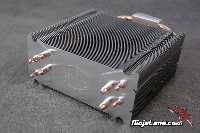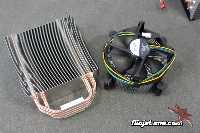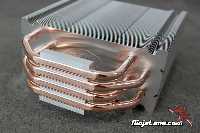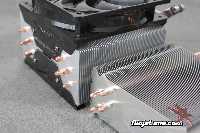After careful consideration I have decided to transfer all hardware review activities to a new domain. I purchased Hardwareasylum.com in 2012 and have been working hard to build a new and improved Ninjalane on that domain. If you are reading this you have reached one of the archived articles, news, projects and/or reviews that were left behind during the site migration.
Please update your bookmarks and be sure to visit the new and improved Ninjalane at Hardwareasylum.com
CoolerMaster Hyper 212 Plus Heatsink Review
Author: Dennis Garcia
Published: Thursday, August 27, 2009
Introduction
One of the best aircoolers we have used here at Ninjalane is the original CoolerMaster Hyper 212, this cooler has been featured in many of our reviews and for good reason. The performance was great even with a single 120mm fan, installation was also extremely easy and straightforward. What most users don't realize is that here in the lab during any particular review we may swap out coolers and processors several times and having a heatsink that can be quickly removed and installed is a great timesaver.
When Coolermaster asked us if we wanted to review the upgraded version of the Hyper 212 we jumped at the chance hoping for a repeat performance.
In this review we will be looking at the Coolermaster Hyper 212 Plus heatsink. This is your standard tower style heatpipe cooler with the radiator being the perfect size for a 120mm fan. Just like the original Hyper 212 there are 4 physical heatpipes bent in the middle giving us twice the cooling capacity. The actual tower is a single radiator design and not unlike some of the other coolers we have reviewed. There are no real performance gains between the single or dual tower design however we suspect the single "simple" design is cheaper to make.
When Coolermaster asked us if we wanted to review the upgraded version of the Hyper 212 we jumped at the chance hoping for a repeat performance.
In this review we will be looking at the Coolermaster Hyper 212 Plus heatsink. This is your standard tower style heatpipe cooler with the radiator being the perfect size for a 120mm fan. Just like the original Hyper 212 there are 4 physical heatpipes bent in the middle giving us twice the cooling capacity. The actual tower is a single radiator design and not unlike some of the other coolers we have reviewed. There are no real performance gains between the single or dual tower design however we suspect the single "simple" design is cheaper to make.
There are several things that have changed on the new Hyper 212 Plus the biggest of these is related to how the heatsink makes contact with the processor. The new design exposes the heatpipes to make direct contact with the processor.
A benefit to this design is that the heatpipe can react quicker to changes in load temperature since the heat no longer needs to pass thru several millimeters of metal. A drawback to this is everywhere you see the metal changing color you will get a gap that needs to be filled with thermal paste. If you don't fill these cracks what paste you do use will not spread properly. As you can also imagine everywhere there is a gap is a place not making direct contact with the processor.
A benefit to this design is that the heatpipe can react quicker to changes in load temperature since the heat no longer needs to pass thru several millimeters of metal. A drawback to this is everywhere you see the metal changing color you will get a gap that needs to be filled with thermal paste. If you don't fill these cracks what paste you do use will not spread properly. As you can also imagine everywhere there is a gap is a place not making direct contact with the processor.
In terms of size the Hyper 212 Plus is slightly thinner than the previous Hyper 212.





